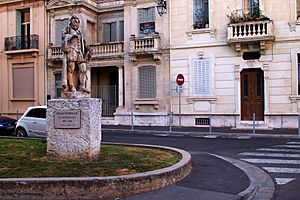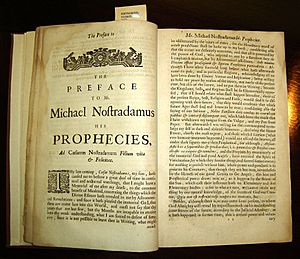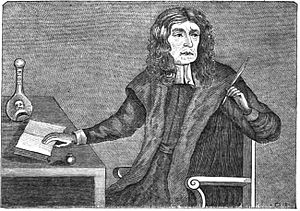Nostradamus facts for kids
Quick facts for kids
Michel de Nostredame
|
|
|---|---|
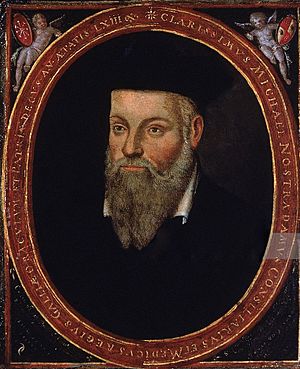
Nostradamus: original portrait by his son Cesar, c. 1614, nearly fifty years after his death
|
|
| Born | 14 or 21 December 1503 |
| Died | 1 or 2 July 1566 (aged 62) Salon-de-Provence, Provence, Kingdom of France
|
| Occupation |
|
| Known for | Prophecy, treating plague |
| Signature | |
Michel de Nostredame (born December 1503 – died July 1566), often called Nostradamus, was a French doctor, pharmacist, and writer. He is famous for his book Les Prophéties (published in 1555). This book contains 942 poems called quatrains, which many people believe predict future events.
Nostradamus's family was originally Jewish but became Catholic before he was born. He studied at the University of Avignon but had to leave because of the Bubonic plague. He worked as a pharmacist and later tried to study medicine at the University of Montpellier. However, he was expelled because being a pharmacist was a "manual trade" not allowed for university students.
He married in 1531, but his wife and two children died from the plague in 1534. Nostradamus bravely helped fight the plague. Later, he remarried Anne Ponsarde and had six more children. He started writing yearly books called almanacs in 1550. These books became very popular. He also worked as an astrologer for rich people, including Catherine of Medici, the Queen of France.
His book Les Prophéties was published in 1555. It used ideas from history and other writings. Some people thought Nostradamus could really see the future. Others believed his predictions were too vague or just misinterpretations. Today, many experts say his predictions are too general to prove he had special powers.
Contents
Life of Nostradamus
Early Years and Education

Nostradamus was born in Saint-Rémy-de-Provence, France, in December 1503. His birth name was Michel. He was one of at least nine children. His father, Jaume, was a notary. His family had been Jewish but converted to Catholicism around 1459.
Not much is known about his early childhood. Some stories say his great-grandfather, a doctor, taught him. However, this great-grandfather disappeared from records when Nostradamus was only one year old.
Student Life and Healing
When he was 14, Nostradamus went to the University of Avignon. He studied subjects like grammar, public speaking, and logic. But after about a year, the university closed because of a terrible outbreak of the plague.
After leaving Avignon, Nostradamus traveled for eight years, starting in 1521. He researched herbal remedies, which are medicines made from plants. In 1529, he tried to become a doctor at the University of Montpellier. But he was soon kicked out. The university found out he had been a pharmacist, which was a "manual trade" not allowed for medical students.
Even after being expelled, Nostradamus continued his work, likely as a pharmacist. He became known for creating a "rose pill" that people thought could protect them from the plague.
Family and Settling Down
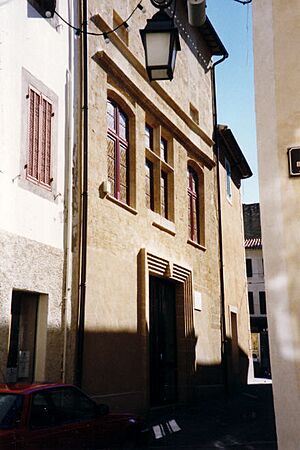
In 1531, Nostradamus moved to Agen and got married. He had two children. Sadly, in 1534, his wife and children died, probably from the plague. After this great loss, he continued to travel around France and possibly Italy.
In 1545, he returned to France to help fight a major plague outbreak in Marseille. He then helped in other towns like Salon-de-Provence and Aix-en-Provence. In 1547, he settled in Salon-de-Provence. He married a wealthy widow named Anne Ponsarde. They had six children together: three daughters and three sons.
Writing Prophecies
After another trip to Italy, Nostradamus started focusing less on medicine and more on writing predictions. In 1550, he published his first almanac, a book of yearly predictions. It was very successful, so he decided to write one or more every year. These almanacs contained thousands of predictions.
Because of his popular almanacs, important people started asking him for horoscopes and advice. He then began writing his most famous book, Les Prophéties. This book contained one thousand poems, mostly in French, that predicted future events. To make his meanings harder to understand, he used unusual sentence structures, word games, and mixed in other languages like Greek, Italian, and Latin.
When Les Prophéties was published, some people thought Nostradamus was evil or a fake. But many powerful people believed in him. Catherine of Medici, the Queen of France, was one of his biggest fans. She read his almanacs and invited him to Paris. She wanted him to explain his predictions and create horoscopes for her children. By the time he died in 1566, Queen Catherine had made him a special advisor and doctor to her son, King Charles IX of France.
Some stories say Nostradamus was afraid of being punished for his beliefs. However, predicting the future or studying stars was not usually seen as a crime back then. He would only have been in trouble if he used magic to support his predictions. He was briefly jailed in 1561 for publishing his almanac without a bishop's permission, which was a new rule.
Final Years and Death
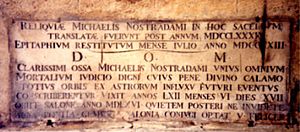
By 1566, Nostradamus was very ill with gout, which caused him a lot of pain and made it hard to move. This illness later turned into edema, which is swelling caused by fluid buildup.
In late June, he made his will, leaving his property to his wife and children. On the evening of July 1, he reportedly told his secretary, "You will not find me alive at sunrise." The next morning, he was found dead. He was buried in a local chapel but later moved to the Collégiale Saint-Laurent, where his tomb is today.
Nostradamus's Works
In The Prophecies, Nostradamus gathered his main long-term predictions. The first part came out in 1555 and had 353 poems. The full version, published after his death in 1568, contains 941 rhyming poems. These poems are grouped into nine sets of 100 and one set of 42, called "Centuries."
Because of how books were printed back then, no two editions of his prophecies were exactly alike. Even the spellings and punctuation could be different.
His Almanacs were his most popular works. He published them every year from 1550 until he died. Sometimes he published two or three in a single year. These books contained detailed or general predictions for the year ahead.
Nostradamus was also a professional healer. He wrote at least two medical books. One was a loose translation of a work by the ancient physician Galen. The other, called Traité des fardemens, was like a medical cookbook. It included his methods for treating the plague, though these methods didn't seem to work. This book also had recipes for cosmetics.
A special old book called the Orus Apollo is kept in the Lyon municipal library. It is believed to be Nostradamus's translation of an ancient Greek work about Egyptian hieroglyphs. However, people at that time didn't truly understand Egyptian writing. It was only correctly figured out in the 19th century.
After his death, only The Prophecies have remained popular. More than 200 editions and 2,000 commentaries have been written about them. They stay popular partly because they are so vague. This makes it easy for people to pick out lines after a big event and claim Nostradamus predicted it.
How the Prophecies Were Made
Nostradamus said his predictions were based on judicial astrology. This is a type of astrology that tries to judge the "quality" of events like births or weddings. However, other astrologers at the time criticized him. They said he wasn't very good at it.
Research shows that much of his prophetic work was actually based on old predictions about the end of the world, especially from the Bible. He also used historical events and old reports of strange signs. He then used astrology to project these ideas into the future. This is why many of his predictions mention ancient figures like Sulla or Nero. They also describe things like "battles in the clouds" or "frogs falling from the sky."
Nostradamus got his historical information from writers like Livy and Plutarch. Many of his astrology references came almost word-for-word from a book by Richard Roussat.
One important source for his prophecies was a book called Mirabilis Liber from 1522. This book contained many prophecies from different authors. Nostradamus was one of the first to rewrite these prophecies in French. This might be why people credit them to him. In the 16th century, it was common for authors to copy and rewrite parts of other books without saying where they got them from.
Nostradamus also used ideas from other books, including one about ancient Egyptian hieroglyphs and another about magic. While he claimed to have burned his magic books, no one knows exactly what was destroyed.
People only started noticing Nostradamus's reliance on older sources in the 17th century. He himself said he was not a "prophet" in the traditional sense.
It's unlikely that Nostradamus used special methods to enter a trance state. He probably just used deep thought and meditation. He described his process as "emptying my soul, mind and heart of all care, worry and unease through mental calm and tranquility." Stories about him gazing into flames or water come from a simple reading of his first two verses. These verses only compare his efforts to those of ancient oracles.
See also
 In Spanish: Nostradamus para niños
In Spanish: Nostradamus para niños




